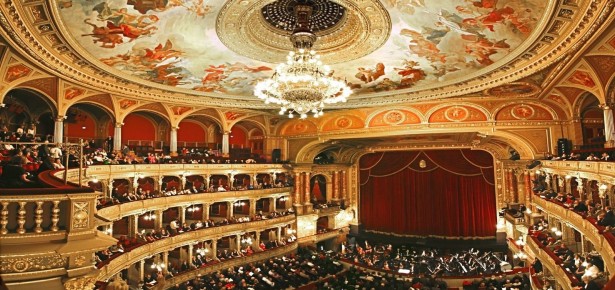
I have long been intrigued by the problem of how music relates to what is widely called “the exotic.” By “the exotic” I mean the various qualities that people in a given locale associate with some faraway place and the people who live there.
Until very recently, the discussion of how the exotic manifests itself in musical works (e.g., operas and symphonic poems) has often been hasty and mired in unspoken assumptions. There has been even less attention to how the exotic shows up in cultural products that—though we may not immediately think of them when we hear the phrase “musical works”—do make substantial use of music. In the latter category I might mention the French popular song “Petite Tonkinoise” (famous from recordings and at least one video by Josephine Baker); Aphra Behn’s play Abdelazer, whose title character is a vicious prince from Morocco (Henry Purcell provided incidental music for a 1695 revival); and the prize-winning Hollywood film The Good Earth, whose film score (composed by Herbert Stothart and Edward Ward) is dramatically effective but—to my ear, at least—relies on a very limited set of pseudo-Chinese musical features, including some taken directly from Puccini’s opera Turandot.
Throughout much of the twentieth century, the topic of exoticism was largely ignored in serious writings on music. There was, for example, no entry on it (nor on a related concept: Orientalism) in any music encyclopedia until the short ones that I wrote for the 1981 New Grove. The lack of discussion no doubt derived in part from longstanding habits of music critics, musicologists, and music theorists. We have tended to take non-programmatic instrumental music as the norm—as the basis upon which we construct our analytical approaches and aesthetic values. In most instrumental works, the relationship between the notes (pitches, rhythms, etc.) and broad and important concepts—such as gender, nation, and, yes, the exotic—is inherently harder to define than in works in which musical elements are combined with non-musical elements such as a descriptive title (in, say, a symphonic poem) or sung words, visual images, plot, and gesture (as in an opera).
I have now completed and published—six years apart—what is, in effect, a big book in two volumes, each of which bears its own title. Musical Exoticism: Images and Reflections deals mostly with works from the nineteenth and twentieth centuries (plus a few from the eighteenth); it was released by Cambridge University Press in 2009 (paperback, 2011). Music and the Exotic from the Renaissance to Mozart is—as its title suggests—a prequel to the 2009 book. It looks at instances of exotic portrayal in a variety of genres from the years 1500-1800; Cambridge released the prequel in June 2015, both as a hardback and as an e-book.
Taken together, the two books set out some principles for grappling with the complex question of how attitudes toward foreign Others—and also toward ethnic, religious, or “racial” Others—are conveyed in musical works (and, as I said, in compound cultural products—films, modern-dance compositions, etc.—that are not, strictly speaking, “musical works”). The instances that are studied range from Baroque-era court ballets (such as a sumptuous one performed at the French royal court, in 1617, about the fabled Syrian sorceress Armide) to solo keyboard pieces (such as “Pagodes,” from Debussy’s Estampes) and popular songs (such as “Under the Bamboo Tree,” by Bob Cole and J. Rosamond Johnson, and Vincent Scotto’s aforementioned “Petite Tonkinoise”).
The two books give frequent attention to the varied world of the musical stage. Between them, they re-examine a number of standard-repertory operas—e.g., Mozart’s The Abduction from the Seraglio (which re-enacts Western stereotypes about Turkish harems) and Verdi’s Il trovatore (with its vivid portrayal of the vengeful “Gypsy” Azucena)—as well as operas that are performed less often, such as Rameau’s Les Indes galantes (which concludes with an evocation of life among North American “savages”). The 2009 book also focuses on some major Broadway musicals, such as Desert Song, The King and I, and West Side Story. (Puerto Rican immigrants in 1950s New York City were widely seen by somewhat longer-established residents, including the show’s Jets, as colorful but also threatening.)
* * *
You have just read the first half of a blogpost that I contributed recently to Musicology Now, the blog of the American Musicological Society. In the remainder of that post, I ask two interrelated questions: How exactly has Western culture portrayed these various cultural Others . . . and why did (and does) it do so? In that post, as in the two books, I illustrate my answers with concrete examples, ranging from Handel (the role of the Egyptian tyrant Tolomeo, in Giulio Cesare) and Mozart (the “Rondo alla turca”) to Rimsky-Korsakov (Sheherazade), Puccini (Madama Butterfly), and beyond. I also provide a bibliography of some major writings on the topic.
Ralph P. Locke is Professor Emeritus of Musicology at the Eastman School of Music (University of Rochester, in Rochester, New York) and founding editor of the book series Eastman Studies in Music (University of Rochester Press). In addition to three books (plus an essay-collection that he coedited and contributed chapters to), he has written numerous articles on the relationship between music and its social and cultural contexts. A list of his writings can be seen here.
Latest Comments
Have your say!